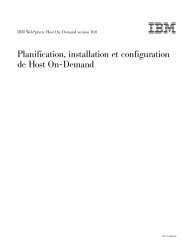Pianificazione, installazione e configurazione di Host On-Demand
Pianificazione, installazione e configurazione di Host On-Demand
Pianificazione, installazione e configurazione di Host On-Demand
You also want an ePaper? Increase the reach of your titles
YUMPU automatically turns print PDFs into web optimized ePapers that Google loves.
<strong>On</strong>-<strong>Demand</strong> come presenti sullo stesso server. Viene qui <strong>di</strong> seguito fornito unesempio della procedura da completare per impostare la funzione <strong>di</strong> proxy sulserver Apache/IBM HTTP:1. Configurare il parametro del portlet <strong>di</strong> <strong>Host</strong> <strong>On</strong>-<strong>Demand</strong> ″URL server HOD″in modo che punti all’host su cui si trova WebSphere Portal, con la ra<strong>di</strong>ce <strong>di</strong>contesto /hod/ (ad esempio, http://portal.company.com/hod).2. Rimuovere il commento dalla riga (rimuovere il segno #) in httpd.conf cheinizia con LoadModule modulo_proxy.3. Aggiungere una regola ProxyPass a httpd.conf per convertire la richiesta <strong>di</strong>un URL server HOD in una richiesta per il server <strong>di</strong> <strong>Host</strong> <strong>On</strong>-<strong>Demand</strong>effettivo (ad esempio ProxyPass /hod/ http://hod.company.com/hod/).4. Riavviare il server Web.Adesso, il browser del client richiederà i file <strong>di</strong> <strong>Host</strong> <strong>On</strong>-<strong>Demand</strong> dallo stessohost del portale, ma queste richieste verranno rein<strong>di</strong>rizzate internamente dalserver Web all’effettiva ubicazione dell’<strong>installazione</strong> <strong>di</strong> <strong>Host</strong> <strong>On</strong>-<strong>Demand</strong>.v Confronto tra memorizzazione nella cache e nessuna memorizzazione nellacache. L’impostazione predefinita nel Wizard per la <strong>configurazione</strong> prevede lamemorizzazione nella cache <strong>di</strong> <strong>Host</strong> <strong>On</strong>-<strong>Demand</strong> su ciascuna macchinadell’utente. Molti utenti gra<strong>di</strong>scono questa opzione con <strong>Host</strong> <strong>On</strong>-<strong>Demand</strong> poichéinstalla effettivamente tutto il co<strong>di</strong>ce necessario sulla macchina dell’utente e nonrichiede carichi <strong>di</strong> rete ogni volta che l’utente accede al file HTML o al portlet.Tuttavia, il comportamento della memorizzazione nella cache potrebbe nonessere familiare a molti utenti <strong>di</strong> Portal Server e si potrebbe pertanto scegliere <strong>di</strong>non utilizzare l’opzione <strong>di</strong> memorizzazione nella cache.v Selezione del modello del Wizard per la <strong>configurazione</strong>. Il modello selezionatoper il portlet (server <strong>di</strong> <strong>configurazione</strong>, HTML o combinato) riflette l’ubicazionedove vengono configurate le sessioni e determina il modo in cui vengonomemorizzate le mo<strong>di</strong>fiche utente. Anche se <strong>Host</strong> <strong>On</strong>-<strong>Demand</strong> tratta i portlet inmodo analogo ai file HTML, valutare le seguenti caratteristiche prima <strong>di</strong>decidere come configurare il portlet:– Modello HTML: Questo modello è il modello <strong>di</strong> <strong>configurazione</strong> consigliatoper i portlet <strong>di</strong> <strong>Host</strong> <strong>On</strong>-<strong>Demand</strong>. Non ha <strong>di</strong>pendenze sul server <strong>di</strong><strong>configurazione</strong> <strong>di</strong> <strong>Host</strong> <strong>On</strong>-<strong>Demand</strong>. Se agli utenti è consentito eseguire degliaggiornamenti, questi aggiornamenti vengono memorizzati come parte della<strong>configurazione</strong> <strong>di</strong> WebSphere Portal e non sulla macchina locale dell’utente.Questo consente agli utenti <strong>di</strong> eseguire il roaming da macchina a macchinacontinuando ad avere accesso agli aggiornamenti.Le preferenze utente vengono memorizzate in WebSphere Portal solo se si èconcesso agli utenti l’accesso appropriato al portlet ed alla pagina Web cheaccederà al portlet. Gli utenti WebSphere Portal V4 devono <strong>di</strong>sporre dell’accesso<strong>di</strong> mo<strong>di</strong>fica (E<strong>di</strong>t) o <strong>di</strong> gestore (Manager) e gli utenti WebSphere Portal V5devono <strong>di</strong>sporre dell’accesso Utente privilegiato (Privileged User), E<strong>di</strong>tore(E<strong>di</strong>tor), Gestore (Manager) o Amministratore (Administrator). Per ulterioriinformazioni su come concedere l’accesso agli utenti, fare riferimento alladocumentazione <strong>di</strong> WebSphere Portal.– Modello basato sul server <strong>di</strong> <strong>configurazione</strong>: Questo modello richiede che gliutenti accedano al server <strong>di</strong> <strong>configurazione</strong> <strong>di</strong> <strong>Host</strong> <strong>On</strong>-<strong>Demand</strong>. Consenteagli utenti <strong>di</strong> eseguire il roaming da una macchina all’altra e <strong>di</strong> continuare avedere le eventuali mo<strong>di</strong>fiche <strong>di</strong> sessione da essi apportate; richiede tuttaviache gli utenti vengano autenticati sia tramite il server <strong>di</strong> <strong>configurazione</strong> <strong>Host</strong><strong>On</strong>-<strong>Demand</strong> che tramite WebSphere Portal.166 IBM WebSphere <strong>Host</strong> <strong>On</strong>-<strong>Demand</strong> Versione 10.0: <strong>Pianificazione</strong>, <strong>installazione</strong> e <strong>configurazione</strong> <strong>di</strong> <strong>Host</strong> <strong>On</strong>-<strong>Demand</strong>






